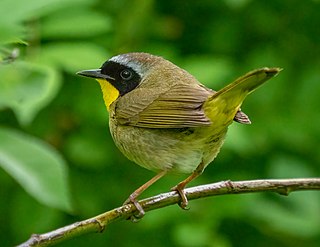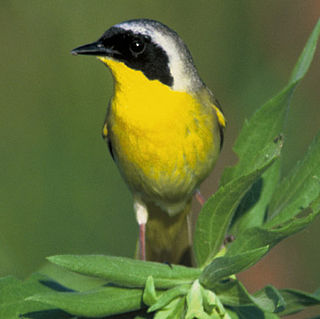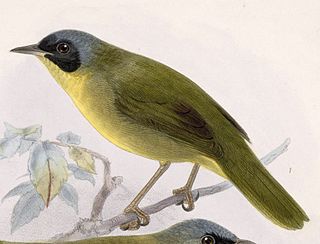
The bay-breasted warbler is a small species of songbird in the New World warbler family, Parulidae. It is one of thirty-four species in the diverse genus Setophaga. Like all songbirds, or passerines, the species is classified in the order Passeriformes.

The common yellowthroat, also known as the yellow bandit or Maryland yellow-throat, is a New World warbler. It is an abundant breeder in North America, ranging from southern Canada to central Mexico. The genus name Geothlypis is from Ancient Greek geo, "ground", and thlupis, an unidentified small bird; thlypis is often used in the scientific names of New World warblers. The specific trichas is also from Greek; trikhas is a kind of thrush, the word being derived from trikhos, "hair".

The mourning warbler is a small songbird of the New World warbler family. Mourning warblers are native to eastern and central North America as well as some countries in Central America. They are neotropical migrants and tend to be found in dense second growth forests. They are under the Wood-warbler category, which consists of arboreal and terrestrial colorful passerines. Wood warblers are in the order Passeriformes, which are perching birds including more than half of all bird species, and the family Parulidae which also includes the Common Yellowthroat, Black and White Warbler, Nashville Warbler, ovenbird, and American Redstart. They are very similar to the MacGillivray's Warbler in appearance, especially in females and immature birds, but their breeding range does not overlap into the west.

The Kentucky warbler is a small species of New World warbler. It is a sluggish and heavy warbler with a short tail, preferring to spend most of its time on or near the ground, except when singing.
The masked yellowthroat is a New World warbler. It has a number of separate resident breeding populations in South America. The black-lored yellowthroat and southern yellowthroat were formerly considered subspecies.

The yellowthroats are New World warblers in the genus Geothlypis. Most members of the group have localised ranges in Mexico and Central America, but the masked yellowthroat has an extensive South American distribution, while the common yellowthroat breeds over much of North America.

Belding's yellowthroat is a New World warbler. It is a resident breeder endemic to the southern Baja California Peninsula (Mexico).

The Bahama yellowthroat is a New World warbler. It is a resident breeder endemic to the Bahamas.

The black-cheeked warbler is a New World warbler, resident breeding bird endemic to the Talamancan montane forests of Costa Rica and western Panama.

The black-bellied sunbird(Cinnyris nectarinioides) is a small sunbird located primarily in Africa. Two subspecies are recognized: the Cinnyris nectarinioides erlangeri, which is smaller and found in Ethiopia, Somalia, and Kenya; and the Cinnyris nectarinioides nectarinioides, which is larger and found in Kenya and Tanzania. This bird inhabits savannah, wetlands, and terrestrial freshwater areas.

The black-lored yellowthroat is a New World warbler. It has a number of separate resident breeding populations in South America from western Ecuador to western Peru. It was previously considered a subspecies of the masked yellowthroat.

The Chiriqui yellowthroat is a New World warbler. It has a number of separate resident breeding populations in Central America from southwestern Costa Rica to Panama. It was previously considered a subspecies of the masked yellowthroat.

The southern yellowthroat is a New World warbler. It has a number of separate resident breeding populations in South America from southeastern Peru, eastern Bolivia, and south Amazonian Brazil to Argentina and Uruguay. It was previously considered a subspecies of the masked yellowthroat.















